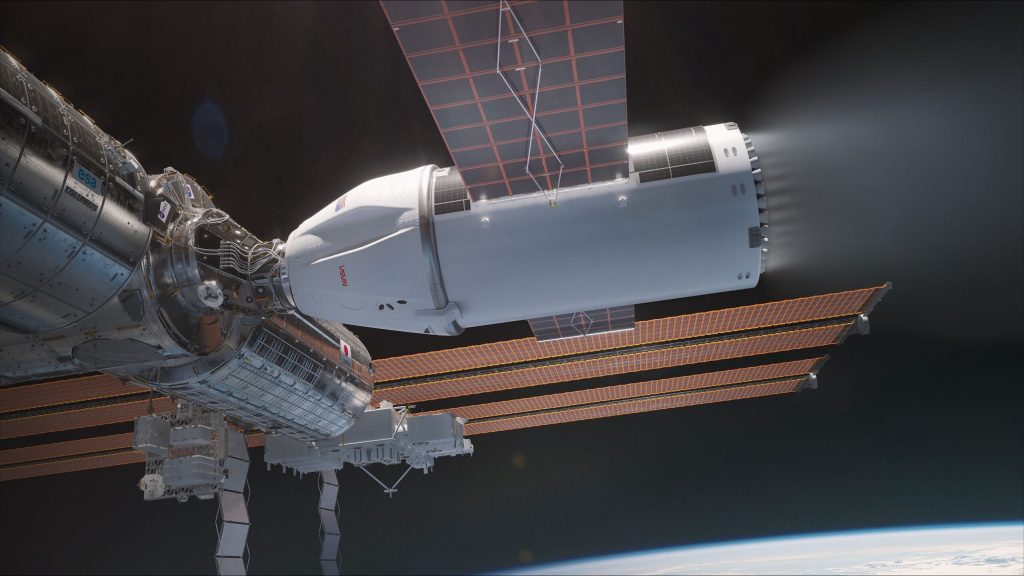BUSAN, South Korea — SpaceX will develop an enhanced version of its Dragon spacecraft to help NASA deorbit the International Space Station in the late 2020s.
During a July 17 briefing, NASA and SpaceX officials revealed new details about the United States Deorbit Vehicle (USDV) spacecraft. NASA selected SpaceX to build the mission on June 26. The contract is worth up to $843 million. At the time of the announcement, neither NASA nor the company had disclosed the spacecraft’s design or specific capabilities.
The USDV is based on SpaceX’s Dragon spacecraft, but with a redesigned fuselage and more Draco thrusters. According to Sarah Walker, SpaceX’s Dragon mission management director, the spacecraft will have 46 Draco thrusters, 16 for attitude control and 30 for maneuvers needed to lower the space station’s orbit at the end of its life.
She said the “enhanced” fuselage section will be twice as long as a regular fuselage and will house the engines, fuel tanks, power generation and other systems. It will store six times as much fuel as the current Dragon spacecraft, and generate and store three to four times as much power. “It’s almost a spaceship in itself,” she said.
NASA, which owns and operates the SpaceX-built USDV, plans to launch it to the ISS shortly after the arrival of the final crew. Once the USDV arrives and is inspected, ISS controllers will allow the ISS to naturally slow its orbit, and the final crew will depart when the ISS reaches an altitude of 330 kilometers, up from its current altitude of about 400 kilometers.
The station’s orbit will be further lowered for about six months, after which NASA will use USDV to perform a final controlled deorbit of the station, targeting an open area of the ocean within a narrow passage about 2,000 kilometers (1,220 miles). Dana Weigel, NASA’s ISS program manager, said the agency expects pieces of the station, ranging in size from a microwave to a sedan, to survive re-entry and splash down in the passage.
The USDV is estimated to have a mass of more than 30,000 kilograms, including 16,000 kilograms of propellant. “It needs to be a heavier class rocket, not the Falcon 9 that’s currently being used for the Dragon missions,” Weigel said. NASA plans to separately procure the launch vehicle at least three years before launch.
“If there is an opportunity for SpaceX to launch USDV, we would be happy to support that,” Walker said.
The only company to bid for USDV was Northrop Grumman. NASA Source Selection StatementNorthrop offered a spacecraft at a price “significantly higher” than SpaceX, which was rated lower on both mission suitability and past performance.
“We were really pleased that we were able to receive proposals from the companies,” said Ken Bowersox, NASA’s associate administrator for space operations. “Honestly, I expected to get a few more proposals, but we’re very pleased with the proposals we received.”
Weigel added that NASA emphasized flight track record in the USDV request for proposals because high reliability was needed to safely land the ISS. “I’m not at all surprised that the current carriers that have already flown and have handled docking and the like with the ISS have bid on it,” he said. “I would have expected a couple of other companies to bid, but I’m not at all surprised that we got two.”
Update on Falcon 9 anomaly
The briefing will be held on The Falcon 9 suffered an anomaly while launching a set of Starlink satellites.A liquid oxygen leak in the rocket’s upper stage prevented that stage’s engine from performing a second burn, placing the satellite in an orbit with a very low perigee.
The accident has grounded the Falcon 9, but Weigel said NASA is currently planning to launch the Cygnus cargo ship aboard one Falcon 9 as early as early August, followed by Crew 9 aboard another Falcon 9 no earlier than mid-August.
SpaceX is working with the Federal Aviation Administration to investigate the anomaly. Before SpaceX can resume launches, it must receive clearance from the agency that the spacecraft does not pose any risk to public safety. “We have our own process that is separate from the FAA process,” Weigel said, noting that the ongoing investigation also includes NASA.
“We continue to work closely with the FAA and all of our customers and things are going very well,” Walker said. “The team has made great progress in the first few days.”
She said they were working to complete an investigation to see what impact that might have on future ISS and other launch schedules. “That’s our number one priority right now,” she said. “In terms of the Dragon team, my team, we continue to maintain nominal launch readiness for several upcoming launches that are scheduled.”


